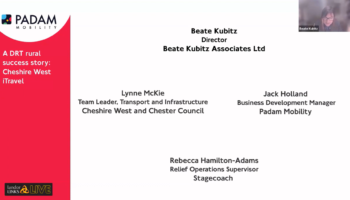The success of DRT service rests on several pillars. In this third and final section, we will discuss the importance of Demand-Responsive Transport business model to ensure its efficiency and sustainability.
When it comes to the economic model of a DRT service, three points must be taken into account: pricing, the operating budget and the vehicle fleet.
1- Demand-Responsive Transport business model: the pricing
The prices of DRT are generally aligned with those of the existing network. However, in some cases, it may be adapted according to the use. For example, on a night service, the fare for the journey may be higher than during the day. Where there is no pre-established transportation network, such as in rural areas, it is possible to set a fare that will vary according to the distance travelled.
2-Demand-Responsive Transport business model: the operating budget
An effective way to optimize the operating budget and save money is to set the trigger threshold. Demand-Responsive Transport by nature operates on a trigger principle (the vehicle(s) will only run if at least one reservation has been made). Nevertheless, it is up to you to go further and define a trigger threshold higher than one reservation. For example, trigger a service from three reservations. The optimal setting of this threshold is highlighted in feasibility studies and simulations prior to launching your network.
It is recommended that you clearly identify the logic of the dynamic DRT software providers behind the capital and operating budget. More and more dynamic DRT solution providers are following a SaaS, Software as a Service model. This model makes it possible to provide a software suite, hosted not on the operator’s computer but on a remote server. In return, the operator pays for a monthly license that includes maintenance and hosting*. This licence is generally calibrated on the use of the DRT solution, which may raise questions about the way local authorities allocate their budget between investment and operation. If you are a local authority, you are encouraged to make your calls for tenders taking care that neither SaaS suppliers nor historical suppliers are excluded by the way the price grid is configured.
Also pay attention to the intellectual property clauses. For SaaS suppliers, intellectual property is the lifeblood of the business. It is therefore very difficult to ask this type of player to deploy its dynamic DRT solution while entrusting maintenance to a third party. This obligation would require them to open access to their code, which would endanger their model and technology.
3- The fleet of vehicles
There are two approaches to making vehicles available to users. They depend on the context in which the Demand-Responsive Transport service is set up. The latter can work thanks to:
- A dedicated fleet: which may be suitable for areas of varying density, where demand is known to be relatively stable and permanent.
- A subcontracted fleet (e.g. to taxi companies): which may be more suitable for low-density areas, where trips are triggered less often.
In addition, as in the case of transport for impaired mobility people, there is increasingly a ‘mixed’ approach. In this case, the goal is to meet demand entirely with dedicated vehicles while having the capacity to respond to peak demand with sub-contracted vehicles.
Asking the right questions about how to understand your user experience, how to parameterize your service design and how to configure your business model, in principle lays the foundation for an efficient and relevant Demand Responsive Transport service. If you would like to know more, and benefit from our advice and expertise, Padam Mobility’s webinars are regularly posted on our YouTube channel.






